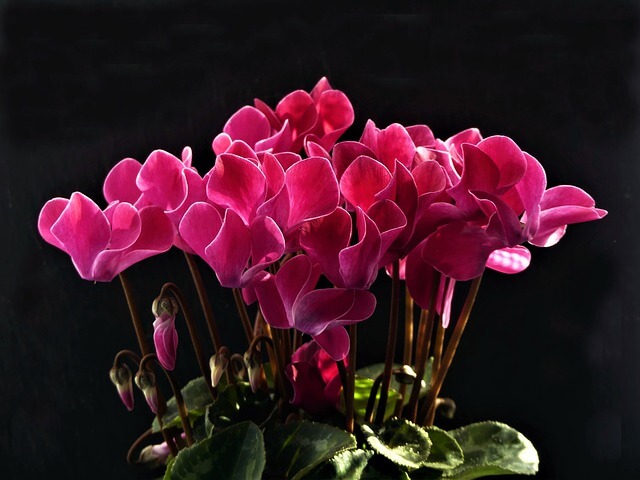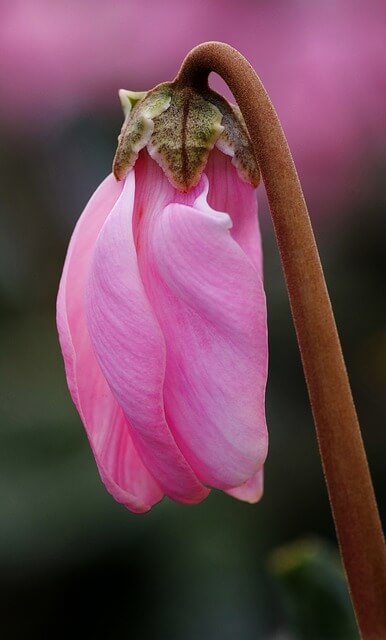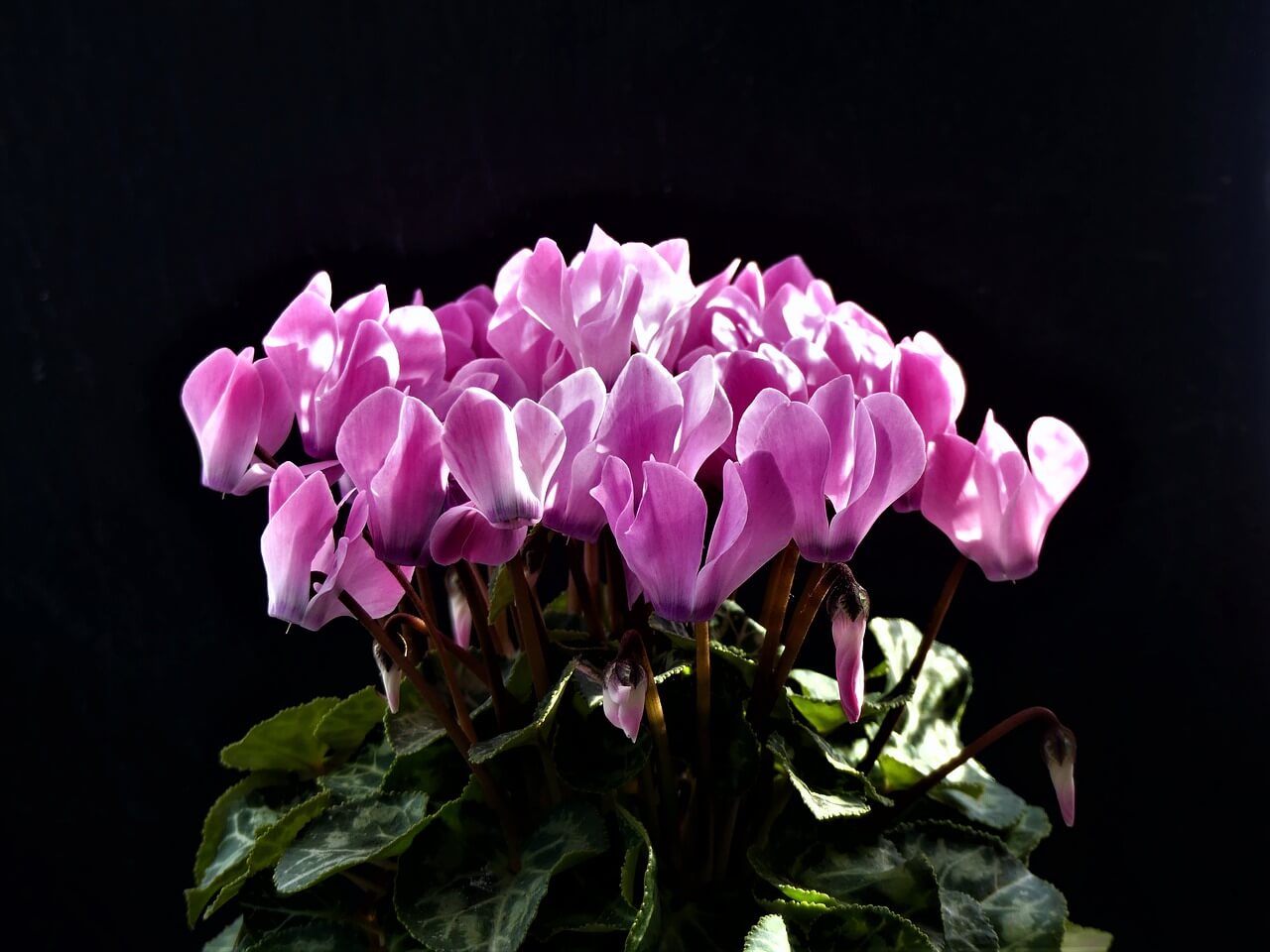Plant Care Instructions for Cyclamen Persicums, Cyclamen Persicum repotting, care tips, lighting, soil, watering, temperature tips.
Distribution and habitat:
Cyclamen persicum is a species of perennial herbaceous flowering plant that grows from a tuber, native to rocky slopes, thickets and forests up to 1.20 m (3,900 ft) above sea level, from the center-south of Turkiye to Israel and Jordan. It also grows in Algeria and Tunisia and in the Greek islands of Rhodes, Karpathos and Crete, where it may have been introduced by the monks. Cultivars of this species are the commonly seen florist cyclamen.
Availability:
Cyclamen persicum is a plant with tuberous root flower, better treated as a temporary indoor plant, to be taken home just when the buds begin to open, enjoy its flowering and discard when the flowering is over.
Cyclamen persicum is often on sale during the fall and winter, in less resistant areas, such as an indoor plant. Plants that are already in shoots usually appear in the market from early winter to spring in resistant areas. The purchased plants must remain decorative for two or three months. The plants are usually purchased in pots of 8cm (3 inches) or 12cm (5 inches).

Source: pixabay.com
Description:
Numerous flowers, produced in individual stems of 23cm (9 inches) in length or more, comprise several petals, of which there are usually five, almost erect. The flowers can be pure white, deep red or various shades of pink, salmon, mauve and purple. Some have white edges on the colored petals; some have wavy edges of petals and some resemble wild species more, as they are small, delicate and pleasantly perfumed, while most cultivated forms have no perfume and have flowers of 2 cm (0.8 inches) or more. long.
The flower stems of Cyclamen persicum plants are raised between the leaves that are market variable in silver, at some point with a wide margin of silver or uneven silver veining. The leaves have stems of long leaves of 10 cm (4 inches) that rise directly from the flattened tuber and cork of the plants.
Cyclamen persicum can flower for two to four months, with individual blooms that last up to three weeks. Once the flowering stops, the plants can survive for several more months.
Care of the indoor plant: remove dead flowers as they wilt and it is important to remove the entire stem of the flower along with the flower. This is easily done by turning the stem and pulling sharply. Any damage or yellowish leaves should also be removed cleanly. When the plants have finished producing flowers, they can be discarded. However, for those who wish to try to bring a Cyclamen persicum in bloom another year, proceed according to the “latency period instructions” below.
Light:
Cyclamen persicum should be administered in winter, during the flowering period, bright light without direct sunlight. While the plant is inactive during the summer, keep it away from the bright light.
Temperature:
Keep Cyclamen persicum fresh all the time. A temperature between 13 ° C (55 ° F) and 18 ° C (64 ° F) is ideal, if possible. Warm conditions will greatly shorten the life of these plants, but high humidity improves things; This can be achieved by placing pots in trays of wet pebbles or an individual pot can be kept in a humid peat bowl. Avoid drafts and hot, dry air.
Do not expose to temperatures below 10 ° C (50 ° F).

Source: pixabay.com
Water:
The tubers of Cyclamen persicum are half buried in the potting mix and water should never be spilled on the tubers, which can rot. Instead, the plants should be watered from below by placing the pot in a container full of shallow water; this allows the mix of pots to take the amount of water you need. After ten minutes, the soaked pots should be lifted and allowed to drain.
Some growers place the pot of Cyclamen persicum on thin pieces of wet foam (or fiberglass), which is kept moist and placed in a shallow dish or container of water; From this, the plant automatically absorbs your water needs. This is also an alternative way to achieve high humidity.
Fertilization:
Apply liquid fertilizer approximately once every two weeks.
Period of latency:
Cyclamen generally go inactive during the summer. They do not like the lack of rain and excess heat, so they take a nap. In the middle of spring, Cyclamen persicum begins to tire and the leaves begin to yellow and die. When they go completely inactive it depends on their growing conditions. If they are indoor plants and the heat stays high, they will extinguish more quickly. On the other hand, some of them never seem to be completely inactive.
During the summer, inactive cyclamen can be kept indoors, in a cool, dark place with good air circulation or outdoors, in a shady place. If placed outdoors, be sure to turn the pot sideways to avoid rain. If the soil gets too wet during dormancy, the tubercle will rot. A little water will not do any harm, but the soil can not remain wet.
Repoten with fresh earth and a slightly larger pot while the plant is inactive. Cyclamen persicum is best planted in a potting mix based on the soil, with the top of the tuber slightly above the soil line.
Start watering again early in the fall. By then, the plant is beginning a new growth. Move the pot inside before a frost.
Uses:
Cyclamen persicum is used on a terrace, in flower boxes, hanging baskets or in bedding: In warm climates you can use Cyclamen persicum for your perennial gardens.
While Cyclamen persicum is more popular as a potted plant, it can be used as a cut flower. The cut cyclamen flowers last in a vase for a surprisingly long time, two weeks or more, and offer the advantage of having a wide range of bright or soft colors at a time when there are not many options, during the winter. They prefer pure water (neither gel nor preservative). The stems should be trimmed regularly at the base and cut into eyelets along (approximately 2 cm (0.8 in)) before being placed back in the vase.

Source: pixabay.com
SUMMARY:
CHARACTERISTICS:
- Foliage – green
- Characteristics – flowers
- Shape – thick
- Height: 15-30 cm (6-12 inches)
APPROPRIATE CARE:
- Irrigation in rest period – without irrigation
- Irrigation during active growth period – moderately
- Bright light
- Temperature in the active growth period – min. 13 ° C max. 18 ° C (55-64 ° F)
- High humidity
- Hardiness zone: 10a-11
Cyclamen Persicum
Light: sun in winter; shade in summer
Temperature: follow the cycle
Humidity: 40 %
Soil: “potting”
Watering: daily during growth, once or twice a week during resting period
Spraying: daily
This plant was very popular at the turn of the century. Because of the special conditions it requires, it lost some of its popularity when central heating was introduced. But its attractiveness is bringing it back into favour.
Cyclamen is a plant that grows very slowly. To flourish, it must be kept in a cool place: 60° to 65° F (16° to 19° C) during the day and 50° to 55° F (10° to 13° C) at night. In winter it may be placed in the sun, but it should not be exposed to hot sun after the beginning of March. Fertilize it every week and water it daily with tepid water so the soil is kept moist at all times. Give your plant a rest after blooming by suspending fertilizing, and watering much less. Repot in early May. During the summer, find a cool place for your plant. Propagation may be done vvith seed-beds but it presents real problems. Once a month a spoonful of vinegar should be added to the water you use for watering so that the soil will be acid.